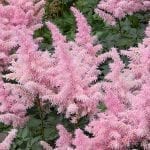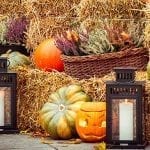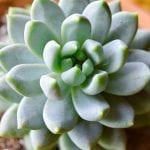
How to Grow Croton Plants for Autumn Enjoyment
Croton (Codiaeum variegatum) plants are prized for their boldly-colored foliage. It’s a plant that is guaranteed to catch your eye when growing in an autumn garden or used as a decoration piece in a fall tablescape.
Here, we’ll give a quick rundown of the plant and how to grow and care for croton plants.
Croton Plants 101
Croton plants are sometimes called “Joseph’s Coat” due to their colorful, leafy display. Moreover, the glossy, variegated leaves grow in autumn-hued colors ranging from red, bronze, purple, yellow, pink, orange, green, bright specks, and stripes.
The attractive leaves are leather-like, glossy, and oval, growing to approximately 18 inches in length.
Note: All parts of the croton plant are poisonous, so if you have curious children or pets, it’s best to place the plant up high on a shelf and out of reach. Not to mention, the milky sap can irritate the skin, so handle these plants with care.
Tips for Growing Croton Indoors
Soil
When it comes to the soil used to plant crotons, make sure to use quality potting soil that drains well. This will ensure your croton grows.
Mature Plant Size
Croton grows from 2 to 4 feet in height when container-grown indoors.
Light & Water Requirements
Croton plants develop their best leaf color when grown in bright, indirect light. A south or southwest-facing window works well. Keep the soil moist and allow the soil to dry out between waterings.
If your indoor humidity is low, mist the foliage weekly. Or, keep a shallow tray filled with water near the plant.
Fertilizer
Fertilize the croton plant twice a year. With this in mind, it’s best to do so in spring and summer.
Temperature Guidelines
Croton plants prefer indoor temperatures that range from 60 to 85°F. Croton in a container can be moved outdoors during warm weather, in cooler areas.
They do not tolerate temperatures below 46°F and should be brought indoors before nighttime temperatures reach 50°F.
Pest and Diseases
Plant diseases are usually not a concern for croton plants when planted indoors. However, nuisance pests such as spider mites, scale, and mealybugs can cause problems.
Spider mites are attracted to crotons grown in drier environments. Symptoms of spider mites include dry-looking leaves and new leaves that die and drop from the plant.
Discourage spider mites by routinely misting the plant. If the problem continues, spray the plant with insecticidal spray.
Scale insects can be identified on foliage as small, oval, and flat with a hard, shell-like covering. Remove them because they will suck the sap from the plant foliage, robbing the plant of the required nutrients.
To remove them, apply a horticultural oil spray or pick them off individually.
Mealybugs appear on plant foliage as tiny puffs of white cotton. Eliminate mealybugs by touching them with an ear swab soaked in alcohol or applying an insecticidal spray.
Click here to learn more about taking care of your mealybug problem.
Tips for Growing Croton in the Garden
Croton plants are semi-tropical and native to northern Australia, Malaysia, and the Pacific Islands. For vivid leaf color, plant croton in a spot that receives plenty of bright, indirect light.
Planting Zones
Croton grows best in plant hardiness zones 10 and 11. Plant croton away from cool north winds.
If you live in a cool climate, it’s best to grow croton indoors in containers.
Outdoor Temperatures
Croton plants do not tolerate temperatures in the 40s or below, so northern gardeners may wish to grow the plant outdoors only during the hottest days of summer.
Cover the plant with a lightweight blanket or burlap bag if your croton is in danger of freezing due to an unexpected cold snap. Keep from breaking limbs by inserting a few stakes in the soil around the plant and gently placing the cover over the top.
Mature Plant Size
Croton plants grown outdoors will typically reach a height of 3 to 6 feet and 2 to 5 feet in width.
Soil
Croton plants grown outdoors prefer organically rich, slightly acidic, and well-drained garden soil.
Light & Water Requirements
Outdoor-grown croton prefers partial sun conditions with afternoon shade. Too much hot midday sun in summer may damage and dry out the foliage.
Your croton plant may shed its lower leaves if planted in too much shade.
Crotons require regular watering. Keep in mind, soil that stays too dry can damage the plants, while wet and soggy places can rot the roots.
For this reason, try to keep the soil evenly moist by adding a layer of mulch around the base of the plant. Mulch will also help to keep the plant’s roots cool.
Fertilizer
Feed croton plants weekly with a balanced fertilizer during the growing season. The plants will also benefit from occasional feeding with fertilizer made for acid-loving plants.
Reduce the amount of fertilization during the cooler months to allow for a rest period.
Pest and Diseases
Croton is a hardy plant that usually isn’t susceptible to plant disease. Instead, watch for signs of insect pests like scale, spider mites, and mealybugs.
Decorating with Croton Plants
The oranges, yellows, and reds of the croton plant work perfectly in autumn arrangements.
Fall Table Arrangement
Place a croton plant in a decorative basket or container. The plant will serve as the focal point. Place a table runner on the dining table. Set the container on the fabric runner. Arrange small pots of mums, marigolds, or succulents around the plant. Fill in with mini pumpkins, pine cones, and candles. Including fall-themed items of different textures and heights add life to a dining area.
Croton plants add beautiful splashes of color to a sunny windowsill, and the warm, autumn-hued foliage blends well with any fall holiday décor. Happen to have some experience growing crotons? Let us know your tips on how to grow crotons indoors in the comments below!












